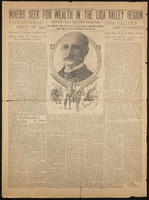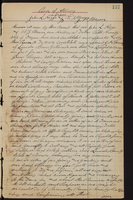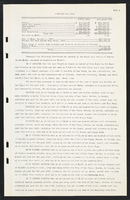Search the Special Collections and Archives Portal
Search Results
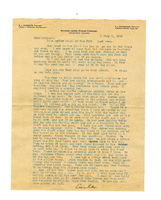
Letter from C. A. Earle Rinker to his mother, July 2, 1908
Date
1908-07-02
Archival Collection
Description
Letter from C. A. Earle Rinker to his mother, July 2, 1908
Text
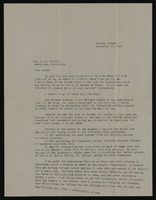
Correspondence, Levi Syphus to Sadie George Clayton
Date
1939-09-17
Archival Collection
Description
This folder is from the "Correspondence" file of the Sadie and Hampton George Papers (MS-00434)
Text
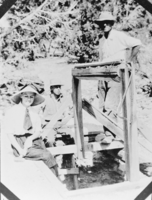
Film transparency of Olive Lake, Herbert Squires, and Charles P. Squires, Mount Charleston, Nevada, 1912
Date
1912
Archival Collection
Description
Black and white image of Olive Lake and two others, presumed to be Herbert Squires and his father, Charles P. Squires, at the Squires' mine at Mount Charleston near Las Vegas. Transcribed notes from Special Collections photo inventory: “Charleston 1912. Olive, Herbert, & Dad at his mine, 2 miles on up the Canyon.”
Image

Film transparency of a ghost town, Delamar, Nevada, 1956
Date
1956
Archival Collection
Description
Some of the abandonded buildings in Delamar, Nevada. A tailing pile from one of the mines is visible in the center of the photograph. A stone structure is visible on the right side of the photograph. Delamar, Nevada, nicknamed The Widowmaker, is a ghost town in central eastern Nevada, USA along the east side of the Delamar Valley. During its heyday, primarily between 1895 and 1900, it produced $13.5 million in gold. In 1889, prospectors John Ferguson and Joseph Sharp discovered gold around Monkeywrench Wash. A mining camp was then born west of the Monkeywrench Mine. It was called Ferguson. In April 1894, Captain Joseph Raphael De Lamar bought most of the important mines in the area and renamed the Ferguson camp as Delamar. In the same year, a newspaper called the Delamar Lode began publication and a post office was opened. Soon, the new settlement boasted more than 1,500 residents, a hospital, an opera house, churches, a school, several businesses and saloons. Most buildings were made of native rock. By 1896, the Delamar mill was handling up to 260 tons of ore daily. Water for the camp was pumped from a well in Meadow Valley Wash, some twelve miles away. Supplies and materials traveled even further, by mule team over mountainous terrain from the railroad head at Milford, Utah, which was 150 miles from Delamar. Silicosis The gold in the Delamar mines was embedded in quartzite which when crushed created a fine dust. Miners breathing the dust often developed silicosis and the town became known as a "widow-maker." Many ruins now stand semi-intact in the Delamar ghost town region. Foundations can easily be seen from adjacent hills. There are two graveyards, which have been vandalized. The area is honeycombed with mines and mineshafts, but in recent years the main shaft has been blasted closed. Wild horses roam the area. The nearby dry lake is known to pilots as Texas Lake because its outline resembles the state of Texas.
Image

Newspaper, The Tonopah Miner, July 20, 1912
Date
1912-07-20
Description
mine net profit reports, directory of mines, SP rail schedule
Text
Grant Snow oral history interview
Identifier
OH-01727
Abstract
Oral history interview with Grant Snow conducted by Elizabeth Nelson Patrick on November 16, 1982 for the Ralph Roske Oral History Project on Early Las Vegas. In this interview, Snow discusses arriving to St. Thomas, Nevada in 1925. Snow also describes teaching in St. Thomas, the significance of mines to the region, and increase of local businesses.
Archival Collection
Pagination
Refine my results
Content Type
Creator or Contributor
Subject
Archival Collection
Digital Project
Resource Type
Year
Material Type
Place
Language
Records Classification

